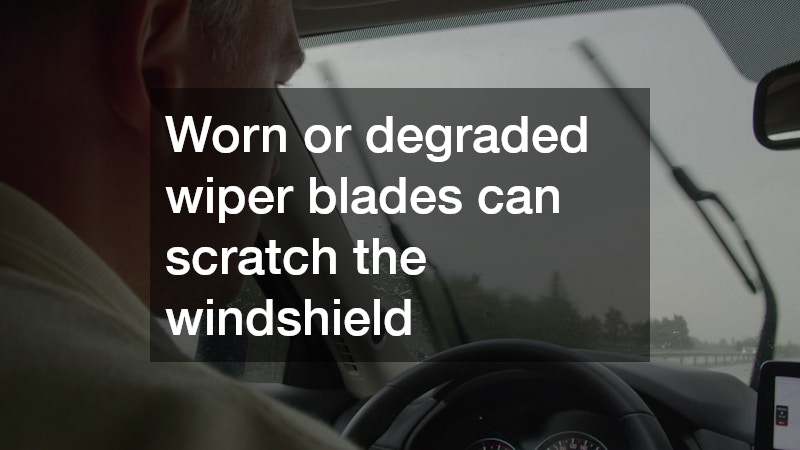-
Fix chips and cracks immediately to stop bigger damage.
-
Clean with care—microfiber and safe cleaners only.
-
Park smart: shade, no debris, no hazards.
-
Keep wipers in top shape to prevent scratches.
-
Choose certified windshield replacement companies for safe, proper installation.
-
Follow your car’s guidelines for maintenance and protection.
-
Protect against extreme weather—defrost gradually and cover when needed.
The windshield is one of the most critical safety components of any vehicle, yet it is often overlooked until a problem arises. It is not merely a barrier against wind, rain, or debris; it also contributes significantly to roof integrity during rollovers, ensures proper airbag deployment, and supports advanced driver-assistance systems (ADAS) such as lane departure warnings and collision avoidance cameras. Despite this, many drivers unknowingly engage in habits that gradually weaken or damage the glass, ultimately requiring professional intervention.
Even seemingly minor issues—like small chips, improper cleaning, or parking in unsafe areas—can escalate into major problems if ignored. Windshield replacement companies often report that a significant portion of their work involves addressing preventable damage. Understanding these common mistakes, why they matter, and how to avoid them can save drivers both money and stress, while also maintaining optimal safety. In this article, we explore the top mistakes that shorten windshield life, provide detailed guidance for avoiding them, and explain how professional care can make a lasting difference.
Neglecting Minor Chips and Cracks
Why Small Damage Matters
Many drivers assume that a tiny chip or crack is harmless, but even minor damage can quickly escalate. Windshield replacement companies frequently highlight that small chips near the edges are particularly dangerous because they compromise the adhesive seal, which secures the glass to the frame and maintains structural integrity. Temperature fluctuations, vibration from driving, and exposure to sunlight can cause a chip to expand into a long crack within days or weeks.
-
Chips and small cracks reduce the windshield’s ability to absorb impact during collisions.
-
Stress fractures near the edges can lead to partial detachment of the glass.
-
Untreated minor damage is a primary reason vehicles require full windshield replacement.
Professional Advice on Repair Timing
-
Inspect your windshield regularly, particularly after long trips or adverse weather.
-
Schedule professional auto glass repair immediately for chips smaller than a quarter; certified technicians can often repair the damage without a full replacement.
-
Avoid relying on DIY kits unless recommended by reputable car glass repair services, as improper application may worsen the problem or distort vision.
By addressing minor damage promptly, you can extend the life of your windshield, maintain vehicle safety, and reduce overall repair costs.
Poor Cleaning Habits
The Risks of Improper Cleaning
Even the most durable glass can be damaged by improper cleaning methods. Harsh chemicals, abrasive pads, or ammonia-based cleaners can weaken the glass, damage tint films, or scratch the surface, which over time reduces visibility and can compromise safety systems.
-
Ammonia-based products can deteriorate factory-installed tint or defroster films.
-
Using rough cloths or scrubbing against dirt and grit can create micro-scratches.
-
Ignoring debris trapped in wiper blades allows dirt to grind against the windshield with each use.
Safe Cleaning Techniques
-
Use microfiber cloths and automotive glass cleaners free of ammonia and harsh chemicals.
-
Rinse the windshield before wiping to prevent debris from scratching the surface.
-
Clean wiper blades regularly and replace them every 6–12 months.
-
Wipe in circular motions rather than straight lines to minimize streaks and stress points.
Professional windshield providers consistently emphasize that safe cleaning practices not only protect glass integrity but also preserve optical clarity, which is crucial for driver safety and the proper functioning of ADAS systems.
Improper Parking Habits
Parking in Direct Sunlight
Extended exposure to the sun can weaken both the windshield glass and the adhesive that holds it in place. Heat causes the glass to expand, and repeated thermal expansion and contraction may lead to micro-cracks that worsen over time.
-
UV rays degrade resin layers in laminated windshields, reducing adhesion.
-
Thermal stress can exacerbate minor chips, turning them into cracks that require full replacement.
Parking Near Trees or Construction Sites
Falling branches, bird droppings, or loose gravel can cause chips or scratches. Even minor damage from these sources may develop into cracks if left untreated.
Best Practices for Parking
-
Park in shaded areas or use a windshield cover to protect against direct sunlight.
-
Avoid parking under trees with loose branches or near construction zones with falling debris.
-
For long-term outdoor parking, consider using protective films or covers recommended by auto glass specialists.
Top windshield replacement companies note that choosing safe parking locations can significantly reduce accidental damage and prolong windshield life.
Weather-Related Mistakes
Sudden Temperature Changes
Rapid changes in temperature are a leading cause of windshield cracking. Pouring hot water on frozen glass or blasting the defroster at maximum heat immediately after a cold night can create stress fractures.
-
Glass expands and contracts with temperature changes; sudden extremes accelerate cracking.
-
Minor chips are far more likely to spread under thermal stress, leading to costly full replacements.
Snow, Ice, and Improper Removal
-
Using metal scrapers aggressively can scratch or chip the glass.
-
Applying excessive pressure to remove ice may worsen pre-existing cracks.
Preventive Measures
-
Defrost gradually using the vehicle’s heater or a low heat setting.
-
Use plastic scrapers or soft-bristled brushes for ice removal.
-
Consider windshield protection sprays or covers to prevent frost buildup.
Professional windshield providers highlight that taking weather-related precautions can greatly reduce the likelihood of damage, especially in regions with extreme seasonal conditions.

Wiper Misuse and Maintenance Neglect
Wiper Wear and Tear
Worn or degraded wiper blades can scratch the windshield, creating micro-grooves that weaken the surface over time. Even premium glass is vulnerable to friction from rubber in poor condition.
Improper Wiper Use
-
Operating wipers on dry or dirty glass grinds dirt into the windshield, causing scratches.
-
Neglecting to clean wiper blades means grit is repeatedly dragged across the glass.
Recommended Maintenance
-
Inspect blades every 3–6 months for cracks, tears, or stiffness.
-
Replace blades regularly to maintain smooth operation.
-
Clean both the windshield and wiper blades before use.
Top auto glass specialists emphasize that wiper maintenance is an often-overlooked yet essential step to prevent scratches and reduce the need for early windshield replacement.
Choosing Low-Quality Replacement or Repair Services
Risks of Substandard Services
Selecting cheap glass or an unqualified installer can result in improper alignment, leaks, or adhesive failure, compromising both safety and durability.
-
Misaligned windshields may allow moisture intrusion, weakening the adhesive.
-
Poorly installed glass can reduce roof support during rollovers.
-
Subpar installation may void warranties and complicate insurance claims.
How Professional Windshield Providers Ensure Longevity
-
Use high-quality OEM or certified aftermarket glass.
-
Follow strict safety and installation standards.
-
Offer warranties covering both materials and workmanship.
-
Calibrate ADAS systems when necessary to ensure proper functionality.
Tips for Selecting Reliable Services
-
Verify certifications from the Auto Glass Safety Council (AGSC).
-
Read reviews and ask about experience with your specific vehicle model.
-
Confirm whether OEM or high-quality aftermarket glass is recommended.
-
Ask whether calibration for cameras and sensors is included.
Working with reputable windshield replacement companies ensures proper installation, maximizes longevity, and maintains safety.
Ignoring Vehicle-Specific Factors
Windshield Technology Considerations
Modern vehicles often include advanced features integrated into the windshield, such as:
-
Cameras for collision avoidance, lane departure, and adaptive cruise control.
-
Rain sensors for automatic wipers.
-
Heated glass for faster defrosting during cold weather.
Using improper glass or installing it incorrectly can disrupt these systems, leading to malfunctions or safety hazards.
Model-Specific Fragility
Some car models have windshields that are more prone to damage due to curvature, thinner glass, or design differences. Awareness of your vehicle’s specific characteristics helps determine proper care and replacement methods.
Consulting the Owner’s Manual
-
Follow manufacturer guidance for cleaning, wiper maintenance, and temperature precautions.
-
Adhering to these recommendations reduces the risk of damage and limits the need for professional windshield replacement.
Preventive Measures to Extend Windshield Life
-
Regular Inspections: Check for chips, cracks, and scratches after storms or long trips.
-
Safe Cleaning: Use microfiber cloths, automotive glass cleaners, and clean wiper blades to prevent scratches.
-
Proper Parking: Avoid direct sunlight, areas prone to debris, and use protective covers when necessary.
-
Weather Precautions: Defrost gradually, avoid thermal shocks, and use soft scrapers for ice removal.
-
Professional Repairs: Address chips promptly, choose certified auto glass specialists for replacement, and ensure ADAS calibration if applicable.
By combining careful habits with professional care, drivers can significantly prolong the life of their windshields and maintain the safety of their vehicles.
Windshields are essential for both safety and structural integrity, yet many drivers unintentionally shorten their lifespan through neglect, improper cleaning, unsafe parking, wiper misuse, and poor replacement choices. Professional windshield providers emphasize that simple preventive measures—like prompt repairs, careful cleaning, routine inspections, and working with certified auto glass specialists—can dramatically extend glass life. By avoiding these common mistakes and prioritizing professional care, drivers can protect their vehicles, reduce repair costs, and maintain optimal safety on the road for years to come.
